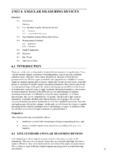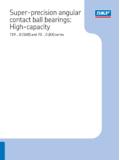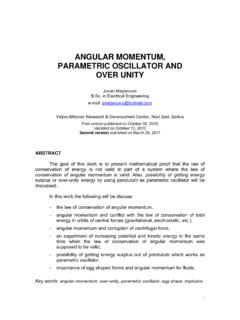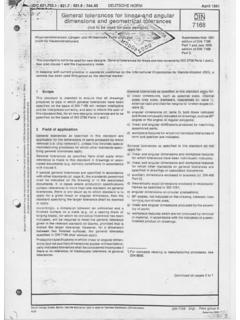Transcription of TORQUE AND ANGULAR MOMENTUM IN …
1 Project PHYSNETP hysics Bldg. Michigan State University East Lansing, MI MISN-0-34 TORQUEANDANGULARMOMENTUMINCIRCULARMOTION shaft1 TORQUEANDANGULARMOMENTUMIN CIRCULARMOTIONbyKirby Morgan,Charlotte,Michigan1. Introduction.. 12. Torqueand AngularMomentuma. De nitions.. 1b. Relationship:~ =d~L=dt..1c. MotionCon nedto a Plane.. 2d. CircularMotionof a Mass..33. Systemsof Particlesa. TotalAngularMomentum.. 4b. TotalTorque.. 4c. RigidBody MotionAbout a FixedAxis.. 5d. Example:Flywheel..5e. KineticEnergyof Rotation.
2 6f. Linearvs. RotationalMotion.. 64. Conservationof AngularMomentuma. Statement of the Law .. 7b. If the ExternalTorqueis not Zero.. 7c. Example:Two Flywheels.. 7d. KineticEnergyof the Two Flywheels..85. NonplanarRigidBodies.. 9 Acknowledgments..9 Glossary.. 92ID Sheet: MISN-0-34 Title:Torqueand AngularMomentumin CircularMotionAuthor:Kirby Morgan,HandiComputing,Charlotte,MIVersio n:4/16/2002 Evaluation:Stage0 Length:1 hr; 24 pagesInputSkills:1. Vocabulary:kineticenergy(MISN-0-20),torq ue,angularacceler-ation(MISN-0-33),angul armomentum(MISN-0-41).
3 2. Solve constant angularaccelerationproblemsinvolvingtorq ue,moment of inertia,angularvelocity, rotationaldisplacement andtime(MISN-0-33).3. Justifythe use of conservationof angularmomentumto solve prob-lemsinvolvingtorquelesschangefromon e stateof uniformcircularmotionto another(MISN-0-41).OutputSkills(Knowledg e) nethe torqueand angularmomentumvectorsfor (a) a singleparticle(b) a systemof 's2nd law, derive its rotationalanalogandstatewhenit can be writtenas a equationfor linearkineticenergyandderive thecorrespondingone for conservationof angularmomentummay not holdinone systembut may if the systemis (ProblemSolving):S1.
4 For massesin circularmotionat xedradii,solve problemsrelatingtorque,moment of inertia,angularacceleration,rotationalki neticenergy, work,and Given a systemin which angularmomentumis changingwithtimedue to a speci edappliedtorque,reconstructthe minimum ex-pandedsystemin which totalangularmomentumis the reactiontorquewhich producesthe compensatingchangein A DEVELOPMENTAL-STAGE PUBLICATIONOF PROJECTPHYSNETThe goalof our project is to assista network of educatorsand scientistsintransferringphysicsfromone personto support manuscriptprocessingand distribution,alongwithcommunicationand alsowork withemployers to identify basicscienti cskillsas well as physicstopicsthatare neededin scienceandtechnology.
5 Anumber of our publicationsare aimedat assistingusersin designed:(i) to be updatedquickly in responseto eldtestsand newscienti cdevelopments; (ii) to be usedin both class-room andprofessionalsettings;(iii)to show the prerequisitedependen-ciesexistingamongth e variouschunksof physicsknowledgeandskill,as a guideboth to mental organizationand to use of the materials;and(iv) to be adaptedquickly to speci cuserneedsrangingfromsingle-skillinstruc tionto ,reviewers and eldtestersare DirectorADVISORY COMMITTEED.
6 AlanBromleyYale UniversityE. LeonardJossemTheOhioStateUniversityA. A. StrassenburgS. U. N. Y., Stony BrookViewsexpressedin a moduleare thoseof the moduleauthor(s)and arenot necessarilythoseof otherproject 2002,PeterSignellfor Project PHYSNET,Physics-Astronomy Bldg.,Mich. StateUniv.,E. Lansing,MI 48824;(517) our liberaluse policiessee: CIRCULARMOTIONbyKirby Morgan,Charlotte,Michigan1. IntroductionJustas for translationalmotion(motionin a straight line),circularorrotationalmotioncan be separatedinto kinematicsand coveredelsewhere,1the discussionherewill centeron to derive the rotationalanalogofNewton'ssecondlaw and thenapplyit to the circularmotionof a singleparticleandto systemsof particularwe wishto developthe relationshipbetween torqueand angularmomentumand discussthecircumstancesunderwhich angularmomentumis Torqueand AngularMomentum2a.
7 De de nedasvectorproductsof position, a force~Factson a particlewhosepositionwithrespect to the originOis thedisplacement vector~r. Thenthe TORQUE \about the point 0 and actingonthe particle,"is de nedas:2~ =~r ~F :(1)Now suppose the particlehas a linearmomentumPrelative to angularmomentumof the particleis de nedas:~L=~r ~p:(2)Thedirectionsof~ and~Lare given by the right-handrulefor crossproducts(seeFig. 1). :~ =d~L= de nitionsof torqueandangularmomentum,we can derive a usefulrelationshipbetween \Kinematics:CircularMotion"(MISN-0-9)and \Torqueand AngularAccel-erationfor RigidPlanarObjects:Flywheels"(MISN-0-33) .
8 2 See \Forceand TORQUE "(MISN-0-5).5 MISN-0-34200(a)(b)F`p`r`qqr` :(a) TORQUE (b) angularmomentum(both directedout of the page).StartingfromNewton'ssecondlaw, writtenin the form~F=d~pdt;(3)the torqueis:~ =~r ~F=~r d~pdt:(4)Thiscan be rewrittenusingthe expressionfor the derivative of a crossproduct:Help:[S-1]~ =ddt(~r ~p) d~rdt ~p=d~Ldt ~v ~p:(5)Now~p=m~vso~v ~p= 0 (becausethe vectorproductof parallelvectorsis zero),so the torqueis:3~ =d~Ldt:(6)Thus the timerateof changeof the angularmomentumof a particleisequalto the torqueactingon MotionCon nedto a ~ =d~L=dtfor aparticletakes on a scalarappearancewhenthe motionof the particleiscon nedto a particleconstrainedto move onlyin thex-yplane,asshown in Fig.
9 2. Thetorqueon the particleis always perpendicularto3 Thisequationis valid onlyif~ and~Lare measuredwithrespect to the `p`r`xFigure2.~r,~F, and~pareall coplanarfor motionin `r` aparticlein circularmotion,~rand~ planeas is the angularmomentum[work this out usingEqs.(1) and(2)].Equivalently, we say that~ and~Lhave onlyz-components. Sincetheirdirectionsremainconstant, : =dLdt(motionin a plane):(7)Thisequationholdsonlyif~Fand~p are in the sameplane;if not (andtheywon'tbe for non-planarmotion),the full Eq. (6) must be CircularMotionof a torqueand angularmomentumfor the specialcaseof a singleparticlein circularmotioncan be easilyrelatedto the particle' a particleof massmmoves about a circleof radiusr withspeed v (notnecessarilyconstant)as shown in Fig.
10 3. Theparticle'sangularmomentumis:~L=~r m~v;(8)but since~rand~vare perpendicular,5the magnitudeof~Lis:L=mvr(9)andthe directionis out of the (9) may be rewrittenintermsof the angularvelocity (sincev=!r) as:L=mr2!:(10)4 Thecomponent equationsare x=dLx=dt, y=dLy=dt, z=dLz= \Kinematics:CircularMotion"(MISN-0-9).7 MISN-0-344 Similarly, the torqueis: =dLdt=mr2d!dt=mr2 ;(11)where is the particle' Systemsof systemof particlesis simplythe sumof the angularmomenta of theindividualparticles,addedvectorially. Let~L1,~L2,~L3,: : :,~LN, be therespective angularmomenta, about a given point, of the particlesin the point is:7~L=~L1+~L2+: : :=NXi=1~Li.









